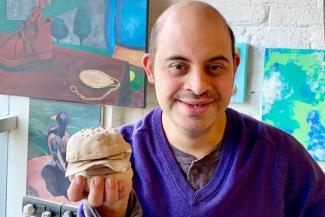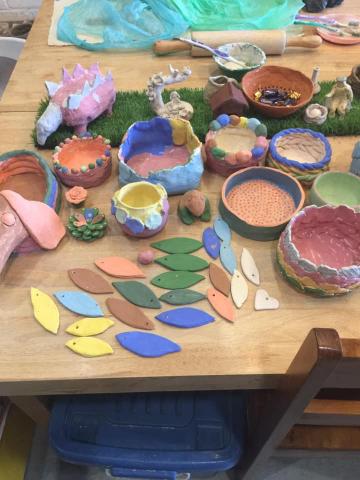
‘I enjoy painting, I love bright colours specially Red’, says Shaurya who is the proud owner of the Banana Studio in Gurugram. Shaurya’s mother Nina Mehrotra recounts her journey with her 31-year-old son who has Down’s Syndrome and how the studio has given him an identity of an artist and a potter.
When was Shaurya diagnosed with Down’s Syndrome and what were the early symptoms?
Shaurya was born on 19th January, 1988. At birth he was a premature baby and while he was recovering from infant jaundice in the hospital he contracted septicemia or blood poisoning. He battled with this severe illness for more than a month and survived against huge odds. The doctors at the hospital termed him a ‘miracle baby’. All this happened without us knowing he was a special child too - with Down’s Syndrome. The recovery from septicemia, a major illness, took a while, and we discovered on one of the visits to a doctor that he is a baby with Downs Syndrome. At that time he was 6 months old. That came as a shock to both my husband and me, but by that stage we had realized that this child was special and had come into our life for a reason.
Shaurya had low muscle tone, single creased palms and his eyes were slanting. The nose has a flat bridge and ears and hands are smaller than usual. The tongue is longer and protruding.
Can you share as to how you went about managing the condition?
As Shaurya was a weak baby, I had to express milk for his feed.. and then supplement with formula milk... later lots of healthy veggies/ khichdi, all blended were given as small meals. We were told all his milestones will be delayed,and he would need therapy.
From Alwar, Rajasthan my husband and I used to take him to Delhi for multiple therapies and interventions and visit a homeopath for improving his immunity. For the first 7-8 years of his life he was a weak child and had frequent respiratory issues. He walked at 18 months and speech was less just a few words. Other than that he was a happy child full of love.
How much support did you get medically and also from your family?
We were a single unit family so all the medical expenses for therapies, doctors and specialists were borne by us. Our parents and extended families were very supportive and included Shaurya and us in all the family get togethers but from the beginning me and my husband put in all our efforts to bring up Shaurya the best we could. To improve strength in his legs we started him on ball play and cycling. Later on in his life he learnt to ride a quad bike and drive a car too! He was very fond of music and loved to dance to Daler Mehndi songs. We also got a puppy for him and he started taking him for walks and playing with him. He was very fond of bright colors specially red, and started using paints with water on paper.
When and how did you think of opening a studio for Shaurya? How has the effort helped?
The beginning was when he showed interest in water, colours, paints in the early school years..Later he started making colourful cards for friends and relatives. We trained him in stamping and embossing with heat gun technique which helped him and another boy with Down’s Syndrome to make good quality greeting cards, wrapping paper, bags, envelopes bookmarks etc. They had a great time selling these stationary items. When we moved to South Africa, Shaurya showed interest in a pottery making workshop which was one of the many wonderful workshops in Lakefarm a residential set up for special needs people just outside the city of Port Elizabeth. He learnt to make small clay items..We lived in S.A. for 3 years and then moved to Thailand where Shaurya continued to learn pottery making in a hobby center. At the end of 3 years of learning he had a solo exhibition in one of the well known galleries of Bangkok. He made about 40 items, and the exhibition was well received by the press and people in Bangkok.
When we came back to India in 2013 we decided to open a studio for him. The dream took the shape of reality. The idea for a studio was that it would become his working space where he can express his thoughts and emotions through the medium of clay. It would also become a platform to reach out to people and invite them to be a part of the studio activities. For Shaurya, the Studio has become his place under the sun and has given him an identity of a being an artist and a potter.
SHAURYASPEAK:
Shaurya replies to some questions as well:
Do you like your Banana Studio? Why?
I like to go everyday, it’s my work place...it’s mine
What do you like to do the most at the studio?
Show everyone how to make a bowl. I love making cars too.
Do you like painting?
I enjoy painting, I love bright colours specially Red!
Do you like it when friends come to see your work at the studio?
I like to show my artworks and take photos with friends
What else do you want to do at the studio?
Call my cousins, friends, masis and party!
How has the studio helped in Shaurya’s development and independence?
Shaurya has become a morning person.. getting ready and going to his office a.k.a studio has become a daily habit. He gets ready on his own with little supervision. He often meets other people in his studio who come either for classes or sometimes to buy his pieces. His loves making bowls, sculptures of human heads, animals and cars. He loves to show off his artworks and talks about them. He has been covered by media, newspapers, online shows and the BBC World channel. He has displayed his artworks in many exhibitions and shows. People have appreciated his work and he has sold many pieces. His confidence and independence has gone up by leaps and bounds. He has overcome many challenges and fears along this journey.

What were some of the challenges you faced and what is your advice to parents who face similar challenges?
Shaurya is 31 years old this year. We faced a lot of challenges initially with his physical health. Walking and cycling are two activities which have helped him tremendously throughout his life. Yoga is very beneficial in keeping him focussed and calm. He enjoys music and dance and it helps him relax as well. There are a lot of things he is not comfortable with - very loud music/ sounds, heated arguments between people, high speed in the car, closed and dark spaces eg auditoriums, halls. One exception is going for movie in cinema halls, usually likes movies with action specially car racing like Fast and Furious series. He loves travelling by air and daytrains.
My advice to parents is that they should take their child with them wherever they go - visiting friends/ family, functions, restaurants, markets, malls, shopping expeditions, picnics, outdoors, holidays, everywhere. Each experience is rich in the development of social skills, cognitive, spatial, etc..and the child getting familiar with all aspects of living in society will help in increasing awareness, building confidence and independence and ultimately being a part of the same social fabric. As for career/ vocational needs we need to understand as parents/ caregivers/ teachers the areas a child is showing interest in, could be as simple as fondness for colours, cooking, or playing in the garden or computer games. The same interest can be worked on to build some area which can ultimately mean a vocation for the child. It requires lots of patience and encouragement. Parents also will sometimes need to be fierce advocates for their kids to make sure they get included in the mainstream and stand up for their rights.
Have you learnt anything in managing Shaurya’s condition that you wish you knew before?
Looking back the only thing I wish is that the doctors had not painted such a bleak picture when they told us that Shaurya is a Down Syndrome baby. We were traumatized when they termed him a ‘vegetable ‘. Shaurya has given us unconditional love and changed us as people.. He inspires us everyday and continues to inspire others as well. He has faced innumerable challenges and has overcome fears and proved to everyone that he is a ‘hero’ and ‘guru’ rolled into one. We are so proud to be his parents.

Pic above: Shaurya in a red shirt on the left with his mother behind a table with his work
Has it been difficult emotionally to cope?
It has been a roller coaster ride with Shaurya, never a dull moment. We went through phases where we found ourselves lonely and looking for answers and not finding any.. Other kids would not include Shaurya for get togethers and that would hurt, we realized also a lack of awareness about special needs is sometimes the reason for staying away. Also as an adult Shaurya loves peer company which he seldom gets as there are few venues for socializing beyond the immediate family. The next big question for us is after we are no more who will take care of him and that is the biggest worry for parents of special needs. There have been many efforts in this direction and parent groups in several cities in India are coming together with the idea of pooling in funds to create residential spaces with long term growth plans which also include helping them find training and jobs For Shaurya we have also invested in a project being set up for persons with special needs in Pune.
Would you like to share some special moments spent with Shaurya?
Too many special moments to recount.. everyday is special with him..
Any thoughts on the theme: Leave no one behind
I believe we have all been created by a superior being and we all have strengths and weaknesses, we don’t have the right to be judgmental about another human being on the basis of ability as that isrelative. Special needs people have unique talents that can bring rewards in their area of work for themselves and their families. when they are trained well. They also bring honesty, integrity and cheer to the workplace. They bring the best out in the people they interact with and hence make our society more human and a better place to live in.






